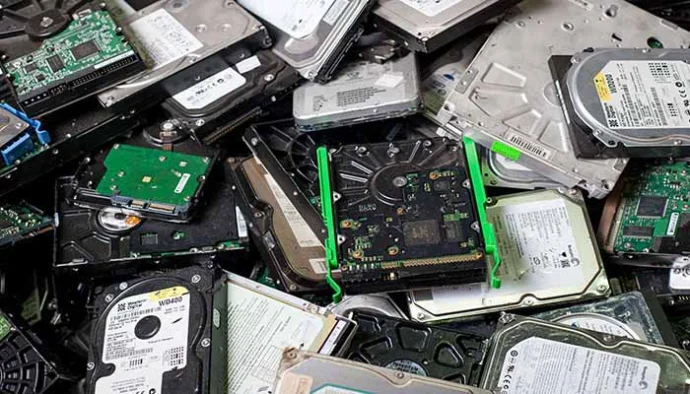How to Dispose of e-Waste in the Datacentre Industry
Is the IT industry driven by technological developments or client needs? Sometimes it is not easy to define the drivers, but one thing is for sure. Innovation in the industry whether its for energy efficiency or scalability, cost reduction or power density, leads to the creation of e-waste or IT computers, servers, accessories, cabling, air conditioners, UPS systems and racks that need to be recycled and as much material as possible reclaimed for later reuse.
The Amount of Electronic Waste is Growing
Last year there were around 50 million metric tons of electronic waste (e-waste) generated globally. That is included equipment that had either failed, reached its end of working life or been supplemented by new technologies. Within the IT category the electronic waste also included mobile phones and consumer electronics. This is a massive sum and the concern is that the number is forecast to grow. There is no evidence that a move to Cloud-based services will slow down the growth of this number. The adoption of Edge computing and the Internet of Things (IoT) will lead to more innovation and the need to upgrade IT products in order to take advantage of the connectivity revolution.
More info: https://www.statista.com/statistics/499891/projection-ewaste-generation-worldwide/
IT Waste Concerns and Issues
The problem with e-waste of any type is that it simply cannot end up in landfill sites without there being complications. Firstly, the electronics and components can contain pollutants and materials that will be harmful to the environment and society in general with the potential to leak into water systems and food chains. UPS batteries are a classic example as they include plastics, hydrochloric acid gels and lead or cadmium plates. Electronics can include gold and chromium coatings than can be recovered. In the future recycling lithium from energy storage batteries will be a problem as there are limited recycling facilities and the methods of lithium recovery are expensive.
Secondly there is a security issue as much of the electronics being recycled stored data. Every company and organisation should ensure that they have an IT Asset Disposal (ITAD) policy in place and that they use the correct processes to ensure that any stored data is removed, and the storage media destroyed and made unrecoverable. Any security breaches can lead to heavy fines from bodies such as the Information Commissioners Office (ICO). More info: https://ico.org.uk/your-data-matters/
IT Asset Disposal Partners
Many companies will look to outsource their IT asset disposal and work with approved companies. This is the approach taken by the Server Room Environments team. When we are called upon to dispose of any form of electrical or electronic waste as part of our removal and recycling service, we have to ensure that we can provide a complete service, that complies with local, national and international government legislation and regulations. We work with experts for the e-waste concerned and use licensed recycling centres and ensure that we can provide traceability and a documented journey for the safe removal and disposal of the assets. We also estimate and monitor the amount of materials that can be recovered from an e-waste project.
We work with partners who have certified waste removal and disposal certification and commitments to the environment. Principle ISO certifications would be ISO 14001 (environmental management standard). The recycling company may also show commitment to other waste recycling certifications including e-Stewards and the SERI (sustainable electronics recycling Industry – https://sustainableelectronics.org/) R2 program as well as working within the EU directives covering WEEE (Waste Electrical and Electronic Directive 2012/19/EU) and RoHS (Restriction of Hazardous Substances 2002/95/EU).
E-Waste Project Management
The first step in any recycling project is an assessment of the e-waste to be removed and disposed. Often the project starts with an enquiry to our projects team. The removal process has a cost to cover logistics and labour. The equipment must be removed from site and the logistics planning for this may be easy i.e. collect from kerbside or require more detailed planning for racks that require dismantling and collection. The removed goods then must be transported to the most appropriate recycling centre and the whole process documented. Some of the materials could recover a rebate sum but often this is not enough to the removal and transportation costs. With any e-waste project photographs can help to provide a good enough overview of the project. A site address and postcode will also be needed to help identify location charges and issues i.e. a red route or congestion zone in London.
Where the removals project is more complex a site survey may be required. This will be completed by one of our project team who will approach the site as though it were a decommissioning project. The goods must be disconnected and made safe to move to a point of collection. In terms of decommissioning the size and weight or logistics route for the goods may be straightforward or the goods themselves may need dismantling. Large server racks, air conditioners, uninterruptible power supplies and network cabling are good examples of projects that can require some form of on-site labour to dismantle the products to make their shipment easier.
Summary
There is little doubt as to the electronics mountain that is building within many companies and the growing need for IT asset disposal services and partners. It is one thing however to remove end-of-life products from a building and another to ensure that they are recycled to the most appropriate level and by certified partners and recycling centres. Waste transfer notes, data destruction certificates and handover notes, all form part of the project documentation to ensure complete visibility of each stage for all the organisations involved in the waste chain.


























